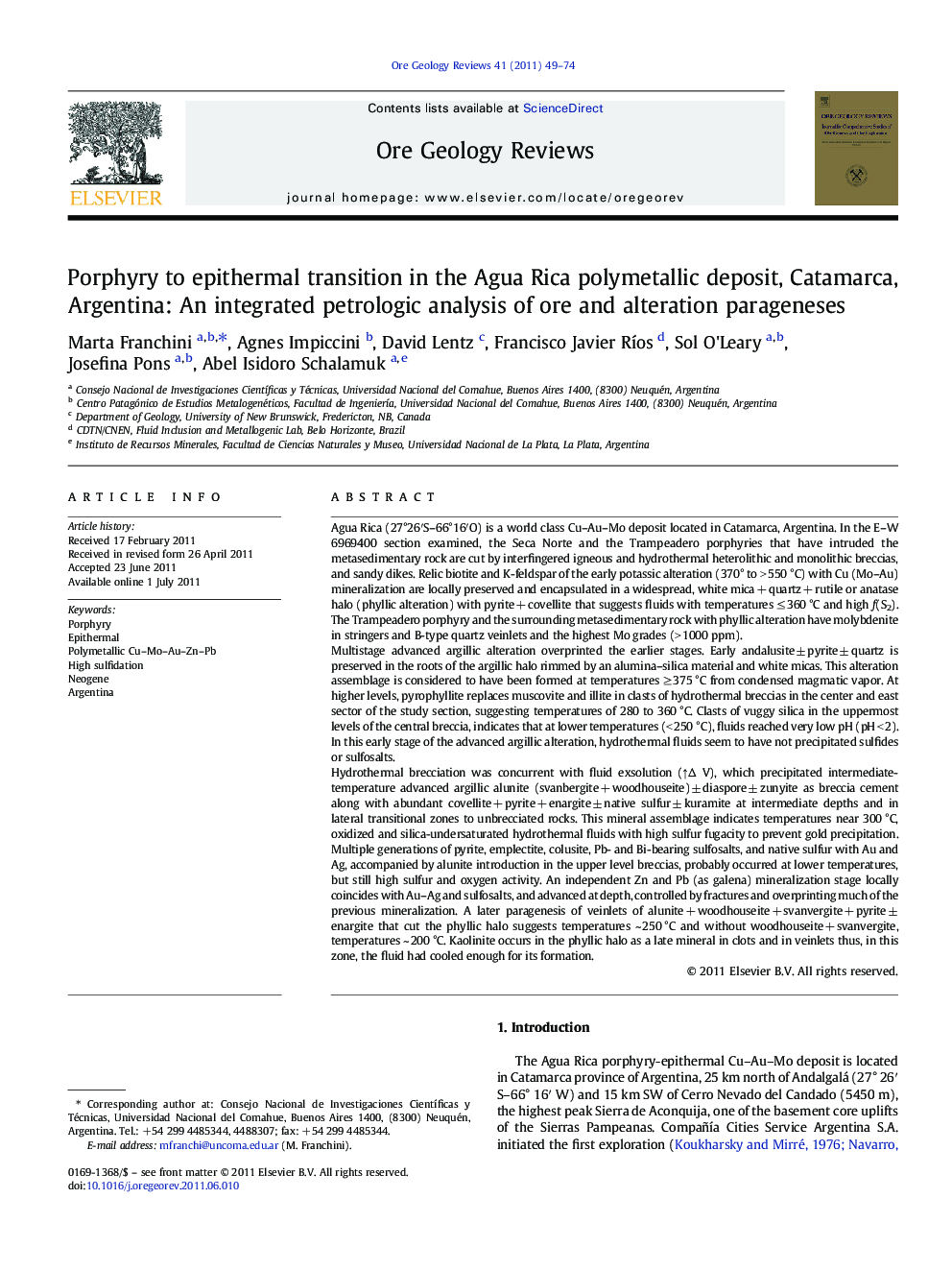| کد مقاله | کد نشریه | سال انتشار | مقاله انگلیسی | نسخه تمام متن |
|---|---|---|---|---|
| 4697690 | 1351893 | 2011 | 26 صفحه PDF | دانلود رایگان |

Agua Rica (27°26′S–66°16′O) is a world class Cu–Au–Mo deposit located in Catamarca, Argentina. In the E–W 6969400 section examined, the Seca Norte and the Trampeadero porphyries that have intruded the metasedimentary rock are cut by interfingered igneous and hydrothermal heterolithic and monolithic breccias, and sandy dikes. Relic biotite and K-feldspar of the early potassic alteration (370° to > 550 °C) with Cu (Mo–Au) mineralization are locally preserved and encapsulated in a widespread, white mica + quartz + rutile or anatase halo (phyllic alteration) with pyrite + covellite that suggests fluids with temperatures ≤ 360 °C and high f(S2). The Trampeadero porphyry and the surrounding metasedimentary rock with phyllic alteration have molybdenite in stringers and B-type quartz veinlets and the highest Mo grades (> 1000 ppm).Multistage advanced argillic alteration overprinted the earlier stages. Early andalusite ± pyrite ± quartz is preserved in the roots of the argillic halo rimmed by an alumina–silica material and white micas. This alteration assemblage is considered to have been formed at temperatures ≥ 375 °C from condensed magmatic vapor. At higher levels, pyrophyllite replaces muscovite and illite in clasts of hydrothermal breccias in the center and east sector of the study section, suggesting temperatures of 280 to 360 °C. Clasts of vuggy silica in the uppermost levels of the central breccia, indicates that at lower temperatures (< 250 °C), fluids reached very low pH (pH < 2). In this early stage of the advanced argillic alteration, hydrothermal fluids seem to have not precipitated sulfides or sulfosalts.Hydrothermal brecciation was concurrent with fluid exsolution (↑∆ V), which precipitated intermediate-temperature advanced argillic alunite (svanbergite + woodhouseite) ± diaspore ± zunyite as breccia cement along with abundant covellite + pyrite + enargite ± native sulfur ± kuramite at intermediate depths and in lateral transitional zones to unbrecciated rocks. This mineral assemblage indicates temperatures near 300 °C, oxidized and silica-undersaturated hydrothermal fluids with high sulfur fugacity to prevent gold precipitation. Multiple generations of pyrite, emplectite, colusite, Pb- and Bi-bearing sulfosalts, and native sulfur with Au and Ag, accompanied by alunite introduction in the upper level breccias, probably occurred at lower temperatures, but still high sulfur and oxygen activity. An independent Zn and Pb (as galena) mineralization stage locally coincides with Au–Ag and sulfosalts, and advanced at depth, controlled by fractures and overprinting much of the previous mineralization. A later paragenesis of veinlets of alunite + woodhouseite + svanvergite + pyrite ± enargite that cut the phyllic halo suggests temperatures ~ 250 °C and without woodhouseite + svanvergite, temperatures ~ 200 °C. Kaolinite occurs in the phyllic halo as a late mineral in clots and in veinlets thus, in this zone, the fluid had cooled enough for its formation.
► This study presents the first complete cross-section analysis using drill core and drill core assay data for the Agua Rica deposit.
► The distribution of the hydrothermal alteration and mineralization and their minerals assemblages along the east–west main section of the Agua Rica deposit, is supported by detail mineralogical and chemical data.
► The results precisely document the porphyry–epithermal transition.
► The results can be very useful for the future mine development.
Journal: Ore Geology Reviews - Volume 41, Issue 1, October 2011, Pages 49–74